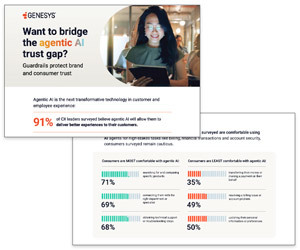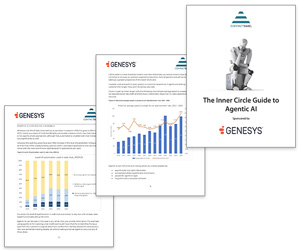Rahul Garg at Genesys explores how, as companies look for more streamlined ways to improve the customer experience (CX), the adoption of conversational artificial intelligence (AI) is pivotal.
The technology helps machines understand people — in human terms. It deals with language across all dimensions. Natural language processing (NLP), natural language understanding (NLU), and speech and text analytics all fall under the conversational AI umbrella.
Companies using conversational AI are seeing positive results, noted Jane Hendricks, Senior Product Marketing Manager, Conversational AI, at Genesys, during the Xperience 2022 session, “Conversational AI 101: What’s now and what’s next.”
Nearly 90% of companies identified as AI leaders are helping to make the customer journey feel more empathetic according to “AI Comes of Age,” a study by Economist Impact. And as a result, these companies have seen increases in customer satisfaction, loyalty and customer lifetime value.
Conversational AI is providing better customer and employee experiences in several ways. Here are just four examples.
- Around-the-clock Insight: Companies use conversational AI, usually in the form of FAQ bots, to provide 24/7 information. These bots can quickly understand what a customer needs, identify the best piece of information to meet that request and then deliver it to the customer.
- Virtual Concierge: This form of conversational AI is popular with organizations that have a complex service delivery model, said Hendricks. A virtual concierge acts as a point of entry – triaging simple questions, identifying the right path for others and connecting the dots where needed. They’re highly effective for decreasing transfer rates and increasing first-contact resolution.
- Transactional Support: This form of conversational AI is designed to help AI perform tasks including anything from a password reset to an airline booking. The ability to transact helps drive engagement with users.
- Agent Assist: In this case, companies use conversational AI to deliver contextually relevant, accurate information as well as recommendations to agents to improve the employee experience and, ultimately, enhance the customer experience.
Delivering a Better Conversational AI Experience
There are a variety of ways to use conversational AI to enhance both the employee and customer experience. That flexibility is one reason for AI’s growing popularity. But rushing into a conversational AI deployment can lead to poor CX — not better experiences.
Hendricks shared four elements of a successful conversational AI implementation.
- Seamless Integration: Conversational AI interfaces must be fully integrated into the customer journey — not off to the side, acting independently. And you need to design bots with transfers in mind to avoid dead ends.
- Omnichannel: Meeting customers on their terms, on their preferred channels, is critical. The ability to build chat bots and voicebots in an omnichannel environment is key.
- Ease of Use: When customers opt for self-service, they assume any bots or conversational AI tools will improve or expedite the experience. Ease of use is also a consideration for bot builders — it means an accelerated time to market, which can be crucial to CX. And business users should be able to easily access data and analytics so they can show the success they’re having with the conversational AI tools. They also can quickly identify any issues and determine how to fix them.
- Engaging Experiences: Design conversational AI implementations to personalize and orchestrate empathetic, engaging customer experiences. If they’re seamlessly integrated across channels and are easy to use, they’re much more likely to deliver a positive experience.
Conversational AI in the CX Market
DenizBank Financial Services Group, one of the largest Turkish private banks, is successfully using conversational AI to improve CX. Esra Turhan, SVP, contact centre at DenizBank, joined Hendricks to talk a bit more about the firm’s approach to AI technology.
According to Turhan, the bank has implemented a proactive service model that anticipates customer needs and helps strike a balance between meeting customers’ expectations and cost reduction. This includes using a virtual voice assistant that spots contact customers who need help.
For example, if a customer is having trouble with his PIN or needs a higher credit limit, the bank proactively calls that customer using conversational AI. Since implementing the technology, the bank has seen a 69% reduction in wait time and a 40% increase in customer satisfaction.
“Customers are given a natural, intuitive experience that’s just like talking to a live human,” said Turhan. “It’s a natural dialog flow.”
Helpline, the European tech support giant, is using conversational AI to be proactive. During the session, Lionel Florence, Director, Users Digital Journeys at the company, discussed how it’s triaging about 30,000 daily inquiries with conversation AI bots.
Helpline implemented omnichannel bots that answer customers’ first-level questions and interpret their answers. This enables the company to qualify customer needs automatically and efficiently. Then it can help customers reach the right agent during that first contact.
The system is so effective at understanding and interpreting customers’ inputs that a bot now handles 100% of all initial interactions.
“Rather than replace humans, they improve the flow of user actions, releasing our technicians for more complex inquiries,” said Florence. “Similarly, using bots to help triage and route inquiries to the right technician eliminates complicated IVR menus, boosting customer experience.”
These successes are just the start. But to make this all happen, conversational AI needs to be more manageable and approachable.
With conversational AI, companies can better connect with their customers and transform customer and employee experiences by making them simpler, more proactive and efficient.
And they can use insights gathered from bot-led customer interactions to optimize the customer and employee experience — all while gaining impressive business results.
This blog post has been re-published by kind permission of Genesys – View the Original Article
For more information about Genesys - visit the Genesys Website
Call Centre Helper is not responsible for the content of these guest blog posts. The opinions expressed in this article are those of the author, and do not necessarily reflect those of Call Centre Helper.
Author: Genesys
Published On: 21st Jul 2022
Read more about - Guest Blogs, Genesys






 Genesys empowers more than 8,000 organisations in over 100 countries to improve loyalty and business outcomes by creating the best experiences for their customers and employees. Through Genesys Cloud, the AI-Powered Experience Orchestration platform, Genesys delivers the future of CX to organisations of all sizes so they can provide empathetic, personalised experience at scale. As the trusted platform that is born in the cloud, Genesys Cloud helps organisations accelerate growth by enabling them to differentiate with the right customer experience at the right time, while driving stronger workforce engagement, efficiency and operational improvements.
Genesys empowers more than 8,000 organisations in over 100 countries to improve loyalty and business outcomes by creating the best experiences for their customers and employees. Through Genesys Cloud, the AI-Powered Experience Orchestration platform, Genesys delivers the future of CX to organisations of all sizes so they can provide empathetic, personalised experience at scale. As the trusted platform that is born in the cloud, Genesys Cloud helps organisations accelerate growth by enabling them to differentiate with the right customer experience at the right time, while driving stronger workforce engagement, efficiency and operational improvements. 












